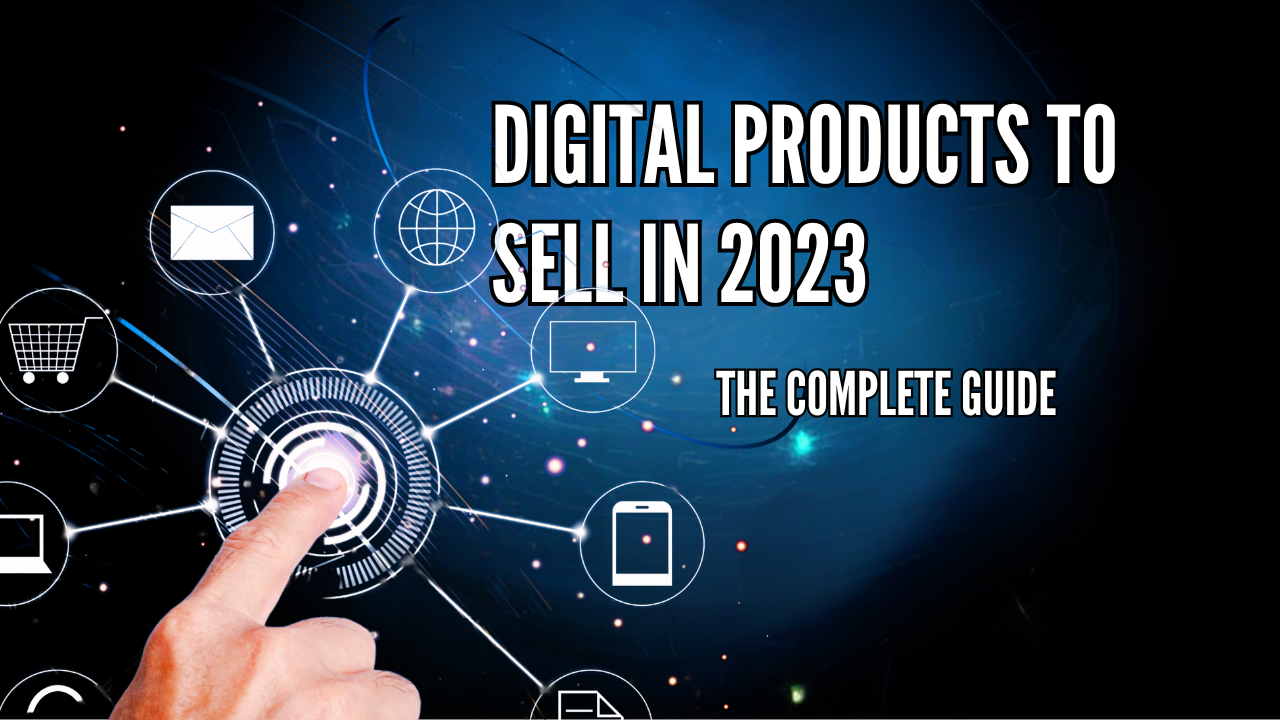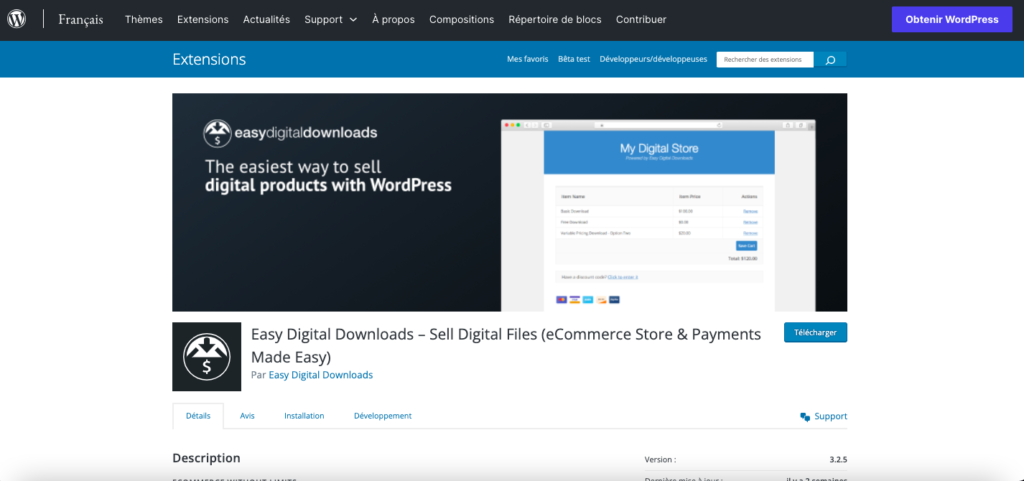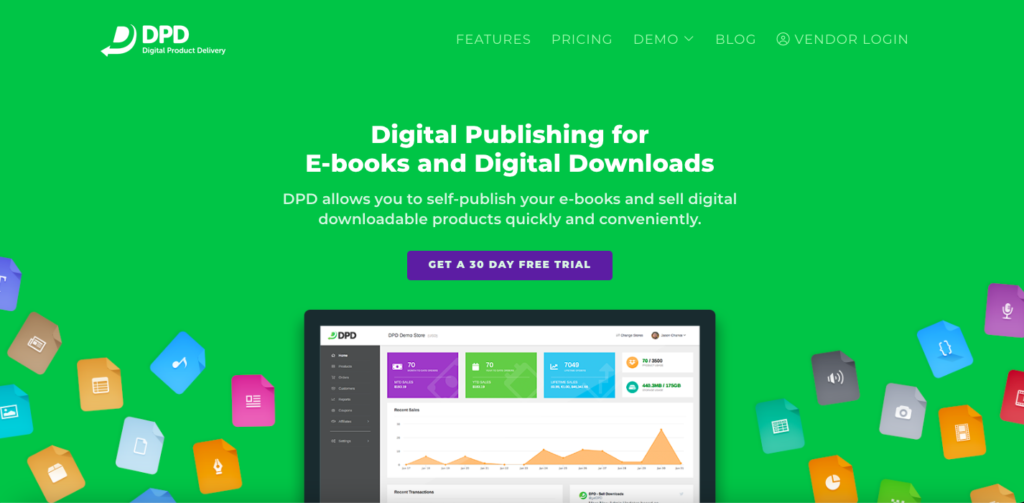
If you’re looking to sell digital products, now is the perfect time to start.
Selling digital products online stands as one of the finest strategies to earn additional income. Whether you’re a freelancer, an aspiring entrepreneur, or someone keen on monetizing digital content, the e-commerce sector presents numerous opportunities.
However, starting a business can be challenging if one lacks initial ideas for digital products. Without adequate knowledge or resources, generating passive income by selling digital products can prove to be difficult.
This article offers a comprehensive guide to assist you in creating and selling digital products. It also explores the most popular digital products today and the best online platforms to sell them, including one of the top website builders available in the market.
What is a digital product?
Digital products, also known as electronic goods, are intangible items for sale. These products are often delivered as online services and digital downloads, such as e-books, stock photos, and mobile applications.
Why sell digital products?
Compared to selling physical products, digital goods offer several advantages. They don’t require physical inventory, allowing for unlimited sales and maximizing the potential for business expansion.
Here are further advantages of selling digital products to quickly earn money online:
- Global reach: Digital products are accessible worldwide, eliminating the need to establish physical stores abroad.
- Cost reduction: Selling digital products lowers business operating costs, such as packaging, storage, and replenishing inventory.
- High profitability: Digital products sell faster than physical products. For instance, Arthur Trusov started selling digital products on a gaming platform in 2019 and earned over a million dollars.
- Ease of adaptation: Sellers can easily modify parts of digital products with minimal effort.
- No shipping: Digital product sellers don’t have to worry about shipping, eliminating risks associated with physical product delivery.
10 ideas for selling digital products online
With the remarkable advantages of selling digital products, it’s no surprise that its popularity continues to grow. In fact, consumers spend over $54 billion annually on digital products.
If you haven’t yet chosen digital items to sell, here are some of the best ideas to help you get started.
Creating a thriving digital products business requires more than just knowledge and resources. That’s why we’ll also explore how to create and sell digital products online.
E-books
E-books are digital publications that can be read on electronic devices such as tablets, phones, or computers. They are one of the best-selling digital products, and the market volume is expected to reach $15.33 billion by 2027.
Fortunately, producing e-books is not challenging. Unlike traditional books that require covers, paper, and ink, e-books only need written content and software to create. Here are some other advantages of e-books:
Compatibility: E-books can be read on most electronic devices due to their smaller file sizes and format compatibility.
Easy marketing integration: Build an email list of interested readers and provide them with valuable content and updates about your e-book. Consider offering a free sample or exclusive discounts to encourage sign-ups.
Simple creation process: You can create e-books using free online software like Canva, Visme, or Adobe Express. To write a successful e-book, consider your passion or expertise. Then, conduct research on the target audience.
Choosing a niche or a topic that interests you or where you excel will make the process more enjoyable. It will also help you produce high-quality content that resonates with your audience.
Pro Tip: If you lack writing skills but want to share your expertise through e-books, consider hiring a writer to compose the content for you.
Once your e-book is complete, explore various e-commerce platforms and strategies for selling digital products. They can assist you in reaching a broader audience and effectively monetizing your valuable knowledge.
Additionally, consider creating a website and using it as an e-commerce platform. Rough Guides, a travel brand, serves as an excellent example of a website for inspiration when selling e-books. The site’s easy navigation ensures an excellent user experience.
Video Courses
Video courses are a fundamental component of the online learning industry. These educational courses typically require significant preparation – selecting the topic, creating the material, and recording the video itself. However, here are some advantages of selling courses online:
- Popularity: Video content is gaining popularity, with statistics showing that an average person spends about 17 hours per week watching videos online.
- Engagement: The audiovisual aspect of videos makes them more engaging. Videos also make the learning process easier and more enjoyable.
- Efficiency: Video courses are usually concise and informative, making them more effective than textbooks for daily consumption.
To succeed in creating and selling video courses, you should have expertise in the field you plan to cover. If that’s not possible, consider hiring an expert to deliver the course on your behalf. However, keep in mind that this will increase production costs.
Other production costs include purchasing a high-quality video camera and editing software to create appealing videos.
Pro Tip: To create professional video courses, you need a course outline that defines learning outcomes. Additionally, plan the production schedule for your video, including scripting, filming, editing, and publication.
Once production is complete, start selling courses online on learning platforms or through your own online course website. Chefdasgulas.com.br serves as a good example.

Membership Sites
Membership sites offer exclusive access to content or services in exchange for a paid subscription. They typically integrate with other e-commerce businesses, including those selling online courses, streaming services, and physical products.
Selling memberships can be a lucrative business opportunity if you have a loyal audience. Devoted followers are likely to enroll in a membership program to access exclusive content.
Benefits such as special discounts, early access to new products, exclusive merchandise, or priority customer service are also appealing. For instance, Spotify Premium rewards customers by allowing them to listen to music without ads and enjoy unlimited skips.
Offering tangible benefits enhances the member experience and promotes brand loyalty. Here are some benefits associated with membership sites:
- Establishing expertise: By offering exclusive and valuable content on your membership site, you can position yourself as an industry expert. Sharing new ideas, advice, and knowledge will help you gain credibility and establish authority.
- Fostering community: A membership website goes beyond content access; it allows you to build a community of like-minded individuals. This sense of community encourages engagement, participation, and a supportive environment that adds value to their experience.
- Increasing your value: Unlike traditional models relying on one-time sales, membership sites accrue value over time. This increase in value translates to higher revenues and profitability for your business.
Pro Tip: Decide on models, pricing plans, and management tools when creating a membership site. If using WordPress, you can build a membership site by integrating plugins like Paid Member Subscriptions and WP-Members.
Stock Photo and Video Banks
From advertising to website design, the demand for stock photos and videos is significant. If you have a passion for photography, consider turning your hobby into a profitable digital business. All you need to start is a good camera and editing software.
The market for stock photography and videos caters to diverse interests. Popular themes include nature, business, technology, lifestyle, and food. Niche subjects targeting specific industries or hobbies also have their own audience.
Consider these factors when preparing your stock photos or videos:
- Quality: Ensure good lighting and composition when taking photos or shooting videos. Experiment with different angles, perspectives, and settings to create visually appealing content.
- Editing process: Editing is crucial to enhance the quality of your photos or videos. Use professional editing software to adjust brightness, contrast, colors, and other elements to make the content visually appealing. You can also apply filters or add text overlays to create a unique style.
- Licensing options: Determine if you want to offer royalty-free licenses or rights-managed licenses. Royalty-free allows buyers to use the content multiple times with certain limitations. Rights-managed offers more control and customization options for a higher price.
Once ready, start selling your photos or videos on your website or online marketplaces like iStock or Shutterstock.
Pro Tip: Enhance the searchability of your media by using keywords and optimizing metadata. Include details like subject, location, emotions, and concepts. Moreover, proper tagging will help buyers find your content more easily on stock platforms.
Digital Art
In today’s creative market, bloggers and content creators often seek high-quality digital artwork to enhance the visual appeal of their content.
If you’re an artist and enjoy working in the creation sector, selling digital artwork online is a great idea. Products can include fonts, illustrations, logos, and icons.
Developing a unique style is crucial to stand out in the competitive market of digital art. Seek inspiration from various sources, experiment with techniques, and refine your skills to create your own distinctive style.
Creating high-resolution digital files and prints ensures the sharpness and professionalism of your artwork. This allows your digital art to be used across different platforms and mediums without compromising its visual appeal.
Important! When pricing your artwork, strike a balance between affordability and fair compensation for your work. Consider factors such as the complexity of the piece, licensing possibilities, and the market demand for similar works.
Consider creating your own website to have better control over your brand and sales process. Additionally, platforms like Etsy, Creative Market, Society6, and Redbubble are popular e-commerce platforms for selling digital artwork.
Mockups and Graphic Design Templates
Mockups and templates are pre-designed layouts that users can customize based on their needs. They serve various purposes, ranging from resumes, cover letters, social media posts, visual designs, to posters.
Pro Tip: Statistics show thousands of monthly searches for website template designs. Seize this opportunity to bolster your authority in the web development field.
Digital templates and mockups usually involve a combination of existing content, layout, and structure. With hundreds of free mockups and templates available, ensure your creations stand out and remain unique.
If you’re a graphic designer, you can utilize these digital products to earn money online. Here are some tips to consider when creating them:
- Ensure versatility: Create mockups and templates that can be easily adapted for different purposes. Allow customization by enabling users to modify elements such as colors, fonts, and layouts.
- Design with customization in mind: Ensure your mockups and templates have editable layers or smart objects. This allows users to easily modify the content.
Using appropriate design software and implementing effective marketing strategies will help establish a strong presence in the graphic design industry.
Adobe Photoshop and Figma are two of the most popular design software and digital tools in the market.
Regarding marketing, offering free mockups or templates is an excellent way to showcase your work to potential clients. This approach can encourage users to try your creations and trust your brand.
When it comes to platforms, you can sell your graphic design mockups and templates on your own website, such as Houseofmockups.com.
Music Tracks and Audio
If you’re passionate about creating music, consider selling digital products in audio format. Although it requires an investment in hardware and software, music can be profitable once you gain popularity or land contracts.
Selling your compositions as stock music is also a good way to earn money. Artists and content creators are always searching for good tracks to use in their projects.
When creating and selling music, there are various genres and styles to explore. Popular genres include pop, rock, hip-hop, and electronic. During the music creation process, follow these tips:
- Invest in quality equipment: Choose a good microphone, audio interface, headphones, and monitors to capture and listen to your music accurately.
- Create a conducive recording environment: Set up a dedicated and soundproof space to ensure good acoustics and minimize background noise.
- Pay attention to microphone placement: Experiment with microphone placement to achieve the desired sound. For example, control proximity effects and use pop filters.
- Utilize professional mixing techniques: Carefully equalize, compress, and add reverb. Balance different elements of your music and create a cohesive sound.
- Mastering for flawless sound: This final step involves optimizing the overall sound, enhancing dynamics, and preparing tracks for distribution. Consider hiring a professional mastering engineer or using mastering plugins for commercially viable sound.
You can sell your audio products on music websites and online music marketplaces. Create a portfolio website to showcase your expertise, music tracks, and samples.
Web Themes and Plugins
If you’re into website development and have ideas to streamline it, consider selling themes or plugins. Themes alter the overall look of a website, while plugins assist website owners in extending their site’s functionality.
Important! Do not confuse website themes with templates.
Website themes offer a complete design set for your website, modifying its appearance from layout to colors and typography. They handle everything, while website templates affect the layout of specific website pages, such as landing pages.
A website theme might include templates, but this isn’t always the case. You can create third-party extensions for popular platforms like WordPress. When creating WordPress themes and plugins, consider the following:
- Prioritize simplicity: Ensure your themes and plugins have intuitive user interfaces that are easy to configure and customize.
- Offer customization options: Provide options to customize the appearance and functionality of your WordPress themes and plugins. Incorporate control panels, color schemes, and flexible layouts to cater to various user preferences.
- Follow coding best practices: Write clean, well-structured code that adheres to standards and conventions. Use proper documentation and add comments to make your code easily understandable and maintainable.
- Extensive testing: Thoroughly test your themes and plugins across different browsers, devices, and operating systems to ensure their compatibility and responsiveness.
By choosing the right programming languages and frameworks, following development best practices, and promoting your products on appropriate marketplaces, you can build a successful business in web development.
Mobile Applications and Games
A profound understanding of coding and programming languages is essential for creating applications and games. Here’s an overview of the app or game development process:
- Coding: App and game development usually begin with writing code. Java, Kotlin, and Swift are popular programming languages for developing app features and logic. Consider the platform you’re targeting before selecting a language.
- UI Development: Designing the user interface is crucial for creating an engaging and intuitive experience. At this stage, you’ll develop screens, layouts, and graphics for user interaction.
- Testing: This critical phase ensures your app or game functions properly. Functional, usability, and compatibility testing are essential for effective evaluation.
Android Studio, Xcode, Unity, and Unreal Engine are some of the most popular app and game development platforms. Appery.io is another intriguing solution that allows you to create an app without coding knowledge.
Pro Tip: Implement App Store Optimization (ASO), in-app purchases, advertising, and referrals as part of your mobile app and game marketing strategies. Don’t forget to use user feedback for continuous improvements.
Coaching and Consultancy Services
If you have expertise suitable for remote regions or valuable knowledge to share, sell your services online. You can offer coaching, consulting, or other service types:
- Life Coaching: Assisting individuals in setting and achieving goals, improving relationships, and overcoming obstacles. Coaches provide guidance, support, and accountability to help clients reach their full potential.
- Business Consulting: Offering expertise and advice to businesses looking to enhance operations, solve problems, or achieve specific goals. Business consultants may specialize in marketing, strategy, finance, or human resources.
- Career Coaching: Helping individuals navigate their careers, explore options, and develop growth strategies. They assist with resume writing, job search strategies, interview preparation, and career transitions.
- Health Coaching: Working with clients to improve their overall well-being, health coaches help set health goals, develop healthy habits, and manage stress. They may focus on nutrition, fitness, weight management, or stress reduction.
Targeting specific niches or sectors is crucial to positioning yourself as an expert and attracting the right clients. It allows you to tailor your services to the specific needs of that market and differentiate yourself from generalists.
For instance, you might specialize in providing career guidance for recent graduates or consulting for startups.
One way to reach potential clients is by having a website like Alvcoaching.com. You can also try platforms like Fiverr, which allow you to register as an independent service provider.
How to Select Profitable Digital Products to Sell Online
Venturing into the sphere of e-commerce and selecting digital products to sell requires time and effort. Here are some general tips for choosing profitable digital downloads:
Keyword and Trend Research
Begin by searching for highly ranked keywords for digital products to sell. This helps identify trending and in-demand product ideas. Compile a list of possibilities and narrow it down to a conclusion.
Google Trends allows exploration, identification, and analysis of search term popularity over time. It provides data on the search interest for specific keywords, related topics, and geographical locations.
By using Google Trends, you can pinpoint trending topics, seasonal trends, and the growing popularity of digital products online. Visit the Google Trends website to explore and search for keywords related to your digital product ideas.
Additionally, use Google Ads Keyword Planner to discover new keywords, analyze their search volume, and obtain bid estimates for advertising campaigns. The tool also provides data on keyword competition and assists in effectively planning your advertising budget.
Market Trend Analysis
Stay informed about the latest market trends in the digital goods industry and discover which types of products are currently in high demand. This will give insight into consumer preferences and help align your product selection with market trends.
To facilitate market research for digital products to sell, gather valuable insights from these websites:
- Exploding Topics: This AI-powered database provides thousands of trending subjects, helping discover emerging e-commerce trends.
- Statista: Obtain information on industry trends, market shares, and consumer behavior. It assists in adapting marketing strategies and making data-driven decisions.
- Pew Research Center: This non-profit organization conducts market studies and analyses in various fields, including U.S. politics, public opinion, demographics, and technology. Generally, their reports provide insights into communication strategies and market analysis.
Assessing Profitability and Demand
Profitability examines how a product or service can generate profits after deducting all costs related to development, production, marketing, and support.
Examining the success of similar products can help assess potential profitability. Here are some indicators to evaluate:
- Gross Profit Margin: This indicator calculates the percentage of revenue after deducting the cost of goods sold. A higher gross profit margin indicates better profitability.
- Net Profit Margin: This represents the percentage of revenue remaining after deducting all expenses, including operating expenses, taxes, and interest. It provides an overview of overall profitability.
- Return on Investment (ROI): ROI measures product profitability and the effectiveness of capital allocation by comparing net profit to the cost of investment.
Demand refers to the number of products or services requested by customers. Understanding customer demand is essential for identifying needs and offering optimal solutions.
When analyzing demand, consider these important parameters:
- Revenue: This indicator measures the total amount of revenue generated by a product’s sales over a given period.
- Unit Sales: Represents the number of products sold within a specific timeframe.
- Customer Acquisition Rate: This calculates the rate of acquiring new customers. A higher acquisition rate indicates growing demand for the product and an expanding customer base.
- Customer Lifetime Value (CLV): Often called CLV, this measure estimates the total revenue expected from customers throughout their lifetime.
Examine these metrics to make informed decisions, maximize revenue, and minimize risks. Utilize frameworks like SWOT analysis to simplify evaluation.
Focus on Value and Unique Proposition
Compelling value and a unique proposition help attract customers and boost sales. Highlighting the distinct qualities of your digital products differentiates them from competitors. For instance, emphasize exceptional quality, functionality, or customer experience.
Ensure your value proposition clearly communicates what your digital products bring to potential customers and how they address their problems. Take the example of a company offering personalized online courses. Their value proposition could be:
“Our online course provides a personalized e-learning experience.
You can tailor the course content to your interests and learning objectives, ensuring a highly relevant and enjoyable learning journey. Our expert instructors provide personalized feedback and support, guiding you through the course material at your own pace.
By customizing your learning experience, we empower you to achieve your educational goals effectively and efficiently. Say goodbye to one-size-fits-all courses and embrace the power of personalized learning with our customized online courses.”
In the above value proposition, the company highlights the key advantages of its personalized online courses. It offers tailored courses that cater to learners’ interests and objectives. The mention of expert instructors providing personalized feedback ensures individualized support throughout the learning process.
Finally, by differentiating its services from generic one-size-fits-all courses, the company appeals to customers seeking a more effective learning path.
Further read: Composable commerce: advantages and advices for setting it up
Where to Sell Digital Products
Online Choosing the ideal e-commerce platform is crucial for the success of a digital products business.
Numerous e-commerce platforms enable sellers to sell digital goods. However, not all platforms may cater to the specific needs of your business. Let’s explore the best e-commerce platforms for selling digital products online.
1. Your Own Online Store
One of the best platforms for selling digital products is your own e-commerce store. You can sell any digital product idea from your website, whether it’s e-books, WordPress themes, or online courses.
Unlike selling digital products on e-commerce platforms, creating an online store allows full control over the functionalities and appearance of your store. It offers the freedom to customize and evolve your online business as per your requirements.
Having your own online store also enhances your brand’s reputation, making you appear more professional. It also reduces competition if other sellers in your niche don’t have an online store.
You can create an online store using a content management system (CMS) and an e-commerce plugin. For instance, WordPress users can utilize WooCommerce.
The CMS option is ideal for those with experience and expertise in website creation. It is also suitable for those unafraid of the learning curve. However, if you’re uncomfortable with the technical aspect of using a CMS, setting up your online store by yourself may be challenging.
For beginners, we recommend using easy-to-implement solutions like an online store builder.
2. Gumroad

Gumroad is a platform that enables artists and creators to sell digital products online. It provides a user-friendly interface suitable for beginners, allowing you to set up an e-commerce store without coding or technical expertise.
To sell digital products, simply upload them to Gumroad and add the automatically generated link anywhere on your website. It will transform that section into a storefront where customers can directly purchase your digital products.
Gumroad allows you to sell digital products in unlimited quantities. Its analytics tool enables you to track views and keep an eye on sales and their sources. If you’re selling software like mobile apps or games, Gumroad enables you to generate license keys.
However, this platform lists products based on download time and doesn’t offer categorization functionality.
Fortunately, Gumroad does not charge monthly fees. Instead, it deducts a 10% fee from each sale.
3. Easy Digital Downloads

Easy Digital Downloads is a WordPress plugin that allows you to sell downloadable products. By integrating the shortcodes generated by the plugin anywhere on your website, you can display and sell digital products seamlessly.
This plugin offers discount codes, download activity tracking, and an integrated reporting tool. You can also set download limits and link expiration to prevent piracy and duplication. It has several free and paid extensions available if you need additional functionalities.
To use this plugin, you need a WordPress website. While you can use this plugin for free, it provides only basic features.
Its premium plans start at $99.50 per month. This plugin is more suitable for an established digital products business due to its higher price point.
As a popular WordPress extension, there’s ample support available, including forums, customer support teams, and tutorials.
Further read: 15 Chrome extensions for your e-commerce and productivity
4. Teachable

If you’re considering selling courses and coaching online, Teachable stands out as an excellent digital sales platform. It boasts an intuitive and straightforward interface that makes site navigation much more user-friendly.
Teachable offers numerous features to support online learning, including various teaching resources, quizzes, course completion certificates, unlimited bandwidth, unlimited courses, and an unlimited number of students for all paid plans.
Regarding store development, you have access to extensive customization options such as customizable pages and built-in affiliate programs. It also supports many third-party integrations like Google Analytics and MailChimp.
Teachable offers a free plan. To unlock more features, opt for premium plans starting from $39 per month, billed annually.
It’s important to note that Teachable applies different transaction fees depending on the plan you choose. The Basic plan, Teachable’s most affordable option, incurs a 5% transaction fee. However, the Pro and Pro+ plans do not charge any transaction fees.
5. MemberPress

MemberPress is a WordPress plugin used to create, manage, and track subscriptions. This plugin allows you to restrict access to specific articles, pages, videos, digital files, or sections of your website. Only members will have access to exclusive content.
This plugin offers various essential features for a membership site:
Content Dripping: MemberPress enables you to schedule content publication over a specific period. Content Expiration: This feature allows you to set access limits to certain content for a specified duration. Coupon Creation: You can create an unlimited number of coupons to encourage customer loyalty. This function also enables you to define coupon expiration dates and the number of uses. Community Building: Through integrations with forum plugins, MemberPress allows you to create an environment where members can interact with each other. Additionally, MemberPress supports multiple payment gateways, including Apple Pay and Google Wallet. With plans starting at $179.50 per year, this plugin is better suited for larger eCommerce businesses.
6. Digital Product Delivery

Digital Product Delivery is another excellent digital sales platform to consider. This PCI-compliant platform enables you to securely sell digital products such as e-books and online courses.
This platform allows you to easily create your online business profile, upload digital products, and generate HTML buttons to embed on your website. It also features an intuitive interface and various functionalities, such as member management and marketing tools.
Moreover, the platform integrates a responsive payment process, enabling customers to purchase products from both desktop and mobile devices. It supports multiple payment processors, including popular options like PayPal, Stripe, and Authorize.net.
Digital Product Delivery packages start at $10 per month with the “pay-as-you-go” pricing model. You can also sign up for a free 30-day trial to see if the platform meets your needs.
Conclusion
Selling digital downloads online offers numerous advantages. Reduced startup costs, high profits, and instant delivery are just a few of these benefits. While navigating the digital products sector can be challenging, thorough research and careful planning can lead to success.
In this article, we’ve explored why digital products are a great way to make money, along with the best digital product ideas, creation tools, and top platforms to sell them.
Let’s briefly recap the three most profitable digital product ideas to consider:
- E-books: Besides their compatibility with different devices, e-books are simple to create and easy to market.
- Video courses: Attractive visuals, relatively short duration, and informative content make video courses more appealing and effective than manuals.
- Membership sites: If you offer online courses or services, setting up a membership program ensures recurring revenue streams.
We hope this article helps you overcome initial hurdles in creating a digital products business and paves the way for your success. If you have any questions about selling digital goods, feel free to ask in the comments section below.





